History of Athens
Athens
Ἀθῆναι | |
|---|---|
Polis | |
Areios Pagos in Athens, by Leo von Klenze (1846) |
- Kingdom of Macedonia 322 BC–148 BC1822–1827, 1832–present
- Roman Republic 146 BC–27 BC
- Roman Empire 27 BC–395 AD
 Eastern Roman Empire 395–1205
Eastern Roman Empire 395–1205 Duchy of Athens 1205–1458
Duchy of Athens 1205–1458 Ottoman Empire 1458–1822, 1827–1832
Ottoman Empire 1458–1822, 1827–1832 Greece
Greece
Athens is one of the oldest named cities in the world, having been continuously inhabited for perhaps 5,000 years. Situated in southern Europe, Athens became the leading city of Ancient Greece in the first millennium BC, and its cultural achievements during the 5th century BC laid the foundations of Western civilization.
During the early Middle Ages, the city experienced a decline, then recovered under the later Byzantine Empire and was relatively prosperous during the period of the Crusades (12th and 13th centuries), benefiting from Italian trade. Following a period of sharp decline under the rule of the Ottoman Empire, Athens re-emerged in the 19th century as the capital of the independent and self-governing Greek state.
Name
The name of Athens, connected to the name of its patron goddess Athena, originates from an earlier Pre-Greek language.[1] The origin myth explaining how Athens acquired this name through the legendary contest between Poseidon and Athena was described by Herodotus,[2] Apollodorus,[3] Ovid, Plutarch,[4] Pausanias and others. It even became the theme of the sculpture on the west pediment of the Parthenon. Both Athena and Poseidon requested to be patrons of the city and to give their name to it, so they competed with offering the city one gift each. Poseidon produced a spring by striking the ground with his trident,[5] symbolizing naval power.

Athena created the
Plato, in his dialogue Cratylus, offers an etymology of Athena's name connecting it to the phrase ἁ θεονόα or hē theoû nóēsis (ἡ θεοῦ νόησις, 'the mind of god').[7]
Geographical setting
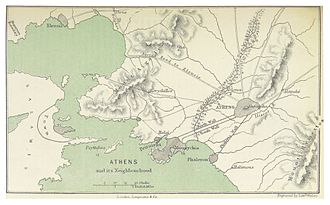

There is evidence that the site on which the
The Agora, the commercial and social centre of the city, lay about 400 m (1,300 ft) north of the Acropolis, in what is now the Monastiraki district. The hill of the Pnyx, where the Athenian Assembly met, lay at the western end of the city. The Eridanus (Ηριδανός) river flowed through the city.
One of the most important religious sites in ancient Athens was the Temple of Athena, known today as the Parthenon, which stood on top of the Acropolis, where its evocative ruins still stand. Two other major religious sites, the
Antiquity
Origins and early history
Athens has been inhabited from
Unlike other Mycenaean centers, such as Mycenae and Pylos, it is unclear whether Athens suffered destruction in about 1200 BC, an event traditionally attributed to a Dorian invasion (though now commonly attributed to a systems collapse, part of the Late Bronze Age collapse). The Athenians always maintained that they were 'pure' Ionians with no Dorian element.[citation needed] However, Athens, like many other Bronze Age settlements, went into economic decline for around 150 years following this.
Founding myths
According to legend, Athens was formerly ruled by kings, a situation which may have continued up until the 9th century BC. From later accounts, it is believed that these kings stood at the head of a land-owning aristocracy known as the Eupatridae (the 'well-born'), whose instrument of government was a Council which met on the Hill of Ares, called the Areopagus and appointed the chief city officials, the archons and the polemarch (commander-in-chief). The most famous king of Athens was Theseus, a prominent figure in Greek Mythology who killed the Minotaur. A slightly different mythical version of Athens' past is given in Plato's dialogue Timaeus. In this dialogue, a story is told about information given to Athenian leader Solon from Egyptian priests of the goddess Neith while he visited Egypt, according to which a well advanced Athenian state was established 9,000 years prior to his time that preceded Egypt's oldest kingdom by a thousand years. The laws of that state were the most just and largely inspired the various kings of Egypt when making laws for their kingdom.[13] This story is not supported by any scholarly evidence, as no Athenian state is known to have existed during the 10th millennium BC. In addition, no evidence exists of any possible cultural or other ties between Egypt and any part of present-day Greece at such early a date.
Classical period
During the
Reform and democracy
| Didrachm of Athens, 545–510 BC | |
|---|---|

| |
| Obv: Four-spoked wheel | Rev: Incuse square, divided diagonally |
| Silver Peisistratus , 545–510 BC
| |
| Obol of Athens, 545–525 BC | |
|---|---|
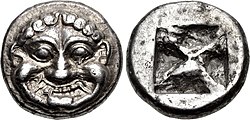
| |
| Obv: A Gorgoneion | Rev: Square incuse |
| An archaic silver obol of Athens of heraldic type from the time of Peisistratus, 545–525 BC | |
The reforms that Solon initiated dealt with both political and economic issues. The economic power of the Eupatridae was reduced by forbidding the enslavement of Athenian citizens as a punishment for debt (
The new system laid the foundations for what eventually became
Peisistratus built the first aqueduct tunnel at Athens,[14] which most likely had its sources on the slopes of Mount Hymettos and along the Ilissos river. It supplied, among other structures, the fountain house in the southeast corner of the Agora, but it had a number of branches. In the 4th century BC it was replaced by a system of terracotta pipes in a stone-built underground channel, sometimes called the Hymettos aqueduct; many sections had round, oval or square access holes on top of about 10 cm × 10 cm (4 in × 4 in). Pipe segments of this system are displayed at the Evangelismos and Syntagma Metro stations.
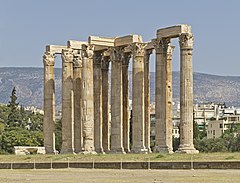
Peisistratos died in 527 BC and was succeeded by his sons
The reforms of Cleisthenes replaced the traditional four , a council which governed Athens on a day-to-day basis. The Assembly was open to all citizens and was both a legislature and a supreme court, except in murder cases and religious matters, which became the only remaining functions of the Areopagus.
Most public offices were filled by lot, although the ten
Classical Athens
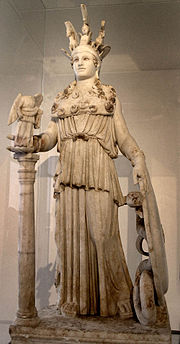
Early Athenian military history and Persian era
Prior to the rise of Athens, Sparta considered itself to be the leader (or
Rev
In 480 BC, the Persians returned under Darius's son
In 479 BC, the Athenians and Spartans, with their allies, defeated the Persian army conclusively at the Battle of Plataea.[16] Athens then took the war to Asia Minor. These victories enabled it to bring most of the Aegean and many other parts of Greece together in the Delian League, an Athenian-dominated alliance.
Peloponnesian War
The resentment felt by other cities at the hegemony of Athens led to the Peloponnesian War, which began in 431 BC and pitted Athens and its increasingly rebellious overseas empire against a coalition of land-based states led by Sparta. The conflict was a drawn out one that saw Sparta control the land while Athens was dominant at sea, however the disastrous Sicilian Expedition severely weakened Athens and the war eventually ended in an Athenian defeat following the Battle of Aegospotami which ended Athenian naval supremacy.
Athenian coup of 411 BC
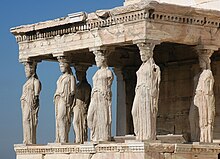
Due to its poor handling of the war, the democracy in Athens was briefly overthrown by a coup in 411 BC; however, it was quickly restored. The Peloponnesian War ended in 404 BC with the complete defeat of Athens. Since the loss of the war was largely blamed on democratic politicians such as Cleon and Cleophon, there was a brief reaction against democracy, aided by the Spartan army (the rule of the Thirty Tyrants). In 403 BC, however, democracy was restored by Thrasybulus and an amnesty was declared.
Corinthian War and the Second Athenian League
Sparta's former allies soon turned against her, due to her imperialist policy, and soon Athens' former enemies
Finally Thebes defeated Sparta in 371 BC in the Battle of Leuctra. But then the Greek cities (including Athens and Sparta) turned against Thebes, whose dominance was stopped at the Battle of Mantinea (362 BC) with the death of its military-genius leader Epaminondas.
Athens and the rise of Macedon
By the mid-4th century BC, however, the northern Greek kingdom of
Artists and philosophers

The period from the end of the
Some of the most important figures of Western cultural and intellectual history lived in Athens during this period: the dramatists Aeschylus, Sophocles, Euripides and Aristophanes, the physician Hippocrates, the philosophers Socrates, Plato and Aristotle, the historians Herodotus, Thucydides and Xenophon, the poet Simonides, the orators Antiphon, Isocrates, Aeschines, and Demosthenes, and the sculptor Phidias. The leading statesman of the mid-fifth century BC was Pericles, who used the tribute paid by the members of the Delian League to build the Parthenon and other great monuments of classical Athens. The city became, in Pericles's words, "the school of Hellas [Greece]."
Hellenistic Athens
Shortly after the death of Alexander the Great, Antipater and Craterus became joint generals of Greece and Macedonia.[20] Athens joined Aetolia and Thessaly in facing their power, known as the Lamian War.[21] Craterus fell in a battle against Eumenes in 320 BC,[22] leaving Antipater alone to rule for a year, till his death in 319 BC.[23] Athens had a central role in the struggle for his succession, when Antipater's son, Cassander, secured the Piraeus leaving Athens without a source of supplies,[20] to contest Antipater's successor, Polyperchon. To consolidate power against Cassander, Polyperchon restored Athens's democracy, as it was before the Lamian War. However, after losing the fleet one year prior, Polyperchon had to flee Macedon when in 316 BC Cassander secured control of Athens. Cassander appointed Demetrius of Phalerum as head of the administration of Athens. Demetrius remained in power until 307 BC when Cassander's enemy, Demetrius Poliorcetes captured Athens,[24] and Macedon, ending the short-lived Antipatrid dynasty and installing his own.
Athens and the rise of the Roman empire
After the
Roman Athens

During the
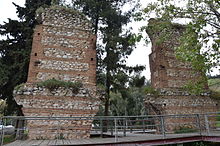
The city was sacked by the Heruli in 267 AD, resulting in the burning of all the public buildings, the plundering of the lower city and the damaging of the Agora and Acropolis. After the Sack of Athens, the city to the north of the Acropolis was hastily refortified on a smaller scale, with the agora left outside the walls. Athens remained a centre of learning and philosophy during its 500 years of Roman rule, patronized by emperors such as Nero and Hadrian.
Late Antiquity
The city remained an important center of learning, especially of
Middle Ages
Byzantine Athens
The city was threatened by
Invasion of the empire by the Turks after the Battle of Manzikert in 1071, and the ensuing civil wars, largely passed the region by and Athens continued its provincial existence unharmed. When the Byzantine Empire was rescued by the resolute leadership of the three Komnenos emperors Alexios, John and Manuel, Attica and the rest of Greece prospered. Archaeological evidence tells us that the medieval town experienced a period of rapid and sustained growth, starting in the 11th century and continuing until the end of the 12th century.
The agora or marketplace, which had been deserted since late antiquity, began to be built over, and soon the town became an important centre for the production of soaps and dyes. The growth of the town attracted the Venetians, and various other traders who frequented the ports of the Aegean, to Athens. This interest in trade appears to have further increased the economic prosperity of the town.
The 11th and 12th centuries were the Golden Age of
Latin Athens
From 1204 until 1458, Athens was ruled by Latins in three separate periods, following the
Burgundian period
Athens was initially the capital of the eponymous Duchy of Athens, a fief of the Latin Empire which replaced the Byzantine Empire, ruling from Constantinople. After Thebes became a possession of the Latin dukes, which were of the Burgundian family called De la Roche, it replaced Athens as the capital and seat of government, although Athens remained the most influential ecclesiastical centre in the duchy and site of a prime fortress.
Under the Burgundian dukes, a bell tower was added to the Parthenon, known as the Frankish Tower. The Burgundians brought chivalry and tournaments to Athens; they also fortified the Acropolis. They were themselves influenced by Byzantine Greek culture.
Aragonese period
In 1311, Athens was conquered by the Catalan Company, a band of mercenaries called Almogavars. It was held by the Catalans until 1388. After 1379, when Thebes was lost, Athens became the capital of the duchy again.
The history of Aragonese Athens, called Cetines (rarely Athenes) by the conquerors, is obscure. Athens was a
Florentine period
In 1388, the
Early modern period
Ottoman Athens
The first Ottoman attack on Athens, which involved a short-lived occupation of the town, came in 1397, under the Ottoman generals Yaqub Pasha and Timurtash.[31] Finally, in 1458, Athens was captured by the Ottomans under the personal leadership of Sultan Mehmed II.[31] As the Ottoman Sultan rode into the city, he was greatly struck by the beauty of its ancient monuments and issued a firman (imperial edict) forbidding their looting or destruction, on pain of death. The Parthenon was converted into the main mosque of the city.[28]
Under Ottoman rule, Athens was denuded of any importance and its population severely declined, leaving it as a "small country town" (
The Turks began a practice of storing gunpowder and explosives in the Parthenon and
In the 18th century, the city recovered much of its prosperity. During Michel Fourmont's visit in the city in the 1720s, he witnessed much construction going on, and by the time the Athenian teacher Ioannis Benizelos wrote an account of the city's affairs in the 1770s, Athens was once again enjoying some prosperity, so that, according to Benizelos, it "could be cited as an example to the other cities of Greece".[36] Its Greek population possessed a considerable degree of self-government, under a council of primates composed of the leading aristocratic families, along with the city's metropolitan bishop. The community was quite influential with the Ottoman authorities, the pasha (governor), the kadi (judge), the mufti (Islamic prelate), and the garrison commander of the Acropolis—according to Benizelos, if the pasha did not treat them well and heed their opinion, he was liable to be removed before his annual term of office was out—particularly through the influence at Constantinople of the two Athenian-born patriarchs of Jerusalem, Parthenius (1737–1766) and Ephram II (1766–1770).[36] Taxation was also light, with only the haraç tax payable to the Ottoman government, as well as the salt tax and a water-tax for the olive yards and gardens.[36]
This peaceful situation was interrupted in 1752–1753, when the execution of the previous Kizlar Agha resulted in the dispatch of a new pasha, Sari Muselimi. His abuse of power led to protests by both the Greeks and the Turks; Sari Muselimi killed some of the notables who protested, whereupon the populace burned down his residence. The pasha fled to the Acropolis, where he was besieged by the Athenians, until the Ottoman governor of

The first owner (malikhane sahib), Ismail Agha, a local Turk from
Ismail Agha's successor,
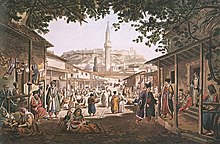
Athens produced some notable intellectuals during this era, such as
His cousin

Independence from the Ottomans
In 1822, a Greek insurgency captured the city, but it fell to the Ottomans again in 1826 (though Acropolis held till June 1827). Again the ancient monuments suffered badly. The Ottoman forces remained in possession until March 1833, when they withdrew. At that time, the city (as throughout the Ottoman period) had a small population of an estimated 400 houses, mostly located around the Acropolis in the Plaka.
Modern history
In 1832,
Athens was chosen as the Greek capital for historical and sentimental reasons. There are few buildings dating from the period of the Byzantine Empire or the 18th century. Once the capital was established, a modern city plan was laid out and public buildings were erected.
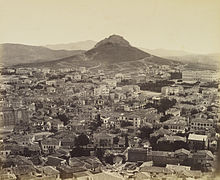
The finest legacy of this period are the buildings of the
Athens experienced its second period of explosive growth following the disastrous


Athens during World War II
Athens was
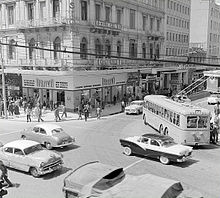
Contemporary Athens
Following World War II the city began to grow again as people migrated from the villages and islands to find work. Greek entry into the European Union in 1981 brought a flood of new investment to the city, but also increasing social and environmental problems. Athens had some of the worst traffic congestion and air pollution in the world at that time. This posed a new threat to the ancient monuments of Athens, as traffic vibration weakened foundations and air pollution corroded marble. The city's environmental and infrastructure problems were the main reason why Athens failed to secure the 1996 Centenary Olympic Games. Following the failed attempt to secure the 1996 Olympics, both the city of Athens and the Greek government, aided by European Union funds, undertook major infrastructure projects such as the new Athens Airport and a new metro system. The city also tackled air pollution by restricting the use of cars in the center of the city. As a result, Athens won its bid to host the 2004 Summer Olympic Games. Despite the skepticism of many observers, the games were a success and brought renewed prestige and tourism revenue to Athens. The 2008 Greek Riots began in Athens following the killing of a 15-year old student by an officer.

Recent historical population
This section needs expansion with: recent census data. You can help by adding to it. (April 2021) |
| Year | City population | Urban population | Metro population |
|---|---|---|---|
| 1833 | 4,000[28] | – | – |
| 1870 | 44,500[28] | ||
| 1896 | 123,000[28] | – | |
| 1921 (Pre-Population exchange) | 473,000[28] | – | |
| 1921 (Post-Population exchange) | 718,000[28] | – | – |
| 1971 | 867,023[44] | – | – |
| 1981 | 885,737 | – | – |
| 1991 | 772,072 | – | 3,444,358[45] |
| 2001 | 745,514[46] | 3,130,841[46] | 3,761,810[46] |
Ancient sites in Athens
- The Acropolis, with the Parthenon
- Agora
- Arch of Hadrian
- Areopagus
- Kerameikos
- Lysicrates monument
- Philopappos monument
- Pnyx
- Temple of Hephaestus
- Temple of Olympian Zeus
- Tower of the Winds
Athenians
Ancient and medieval periods
- mythical king
- Solon (c. 640–560 BC), statesman
- Cleisthenes (c. 570–500 BC), statesman
- lyric poet
- Miltiades the Younger (c. 550–489 BC), statesman and general
- tragicpoet
- Themistocles (c. 524–459 BC), politician and general
- Cimon (c. 510–450 BC), statesman and general
- Apollodorus Skiagraphos(fifth century BC), painter
- Sophocles (c. 496–406 BC), tragic poet
- Pericles (c. 495–429 BC), statesman and general
- Herodotus (c. 484–425 BC), historian, originally from Halicarnassus
- Euripides (c. 480–406 BC), tragic poet
- Pheidias(c. 480–430 BC), sculptor, painter and architect
- Milet
- Nicias (c. 470–413 BC), politician and general
- Socrates (c. 469–399 BC), philosopher
- Telecleides (fl. 450–430 BC), playwright of the Old Comedy
- Thucydides (c. 460–400 BC), historian and general
- Hermippus (fifth century BC), playwright of the Old Comedy
- Peloponnesian war
- Alcibiades (c. 450–404 BC), statesman, orator and general
- Ephialtes of Athens(c. 450–461 BC), politician
- Agathon (c. 448–400 BC), tragic poet
- Eupolis (c. 446–411 BC), playwright of the Old Comedy
- Aristophanes (c. 446–386 BC), playwright of the Old Comedy
- Thrasybulus (c. 440–388 BC), general and democratic leader
- Xenophon (c. 430–354 BC), historian, soldier and mercenary, and a student of Socrates
- Plato (c. 425–348 BC), philosopher
- Menander (c. 341–290 BC), playwright of the New Comedy
- Chalkidike
- Demosthenes (384–322 BC), statesman and orator
- St. Dionysius the Areopagite (c. 1st century AD), judge, early convert to Christianity, and first Bishop of Athens
- apologist
- Christian theologian
- Aelia Eudocia Augusta, born as Athenaïs, later Saint Eudocia (c. 401–460 AD), wife of Emperor Theodosius II
- Saint Giles (c. 650–710 AD), hermit saint
- Byzantine empress
- Demetrios Chalkokondyles (1423–1511), scholar
- Saint Philothei, née Revoula Benizelos (1522–1589), martyrand saint
- Leonardos Philaras (1595–1673), scholar, politician and diplomat
Modern period
- Panagis Kalkos (1818–1875), architect
- Stefanos Dragoumis (1842–1923), judge, writer and Prime Minister of Greece
- Dimitrios Rallis (1844–1921), politician and reiterate prime minister (1897, 1904, 1905, 1909, 1920–21)
- shooter
- Constantine I of Greece (1868–1923), King of the Greeks (1913–17, 1920–22)
- Ion Dragoumis (1878–1920), diplomat, philosopher, writer and revolutionary
- Ioannis Rallis (1878–1946), Prime Minister of Greece (1943–44)
- Prince Andrew of Greece and Denmark (1882–1944), son of King George I of Greece, father of Prince Philip, Duke of Edinburgh
- Field Marshaland Prime Minister (1952–55)
- Helen of Greece and Denmark (1896–1982), daughter of King Constantine, mother of King Michael I of Romania and Queen Mother of Romania
- Alexander I of Greece
- Paul of Greece (1901–1964), King of the Greeks (1947–1964)
- Dora Stratou (1903–1988), singer, dancer and choreographer
- Princess Irene, Duchess of Aosta (1904–1974), fifth child and second daughter of Constantine I of Greece
- Angelos Terzakis (1907–1979), writer
- shipping tycoon
- Melina Mercouri (1920–1994), actress, singer and politician
- Dimitri Terzakis (born 1938), composer
- Stavros Dimas (born 1941), politician and former European Commissioner (2004–09)
- Lucas Papademos (born 1947), economist and Prime Minister of Greece (2011–12)
- Maria Farantouri (born 1947), singer
- Arianna Huffington (born 1950), author and journalist
- Antonis Samaras (born 1951), politician
- Louka Katseli (born 1952), economist and politician
- Dora Bakogianni(born 1954), politician
- Kostas Karamanlis (born 1956), politician and Prime Minister of Greece (2004–09)
- Toula Limnaios (born 1963), dancer and choreographer
- Pavlos, Crown Prince of Greece (born 1967), eldest son and second child of Constantine II
- Leonidas Kavakos (born 1967), violinist and conductor
- Kyriakos Mitsotakis (born 1968), politician and Prime Minister of Greece (2019–present)
- Giorgos Lanthimos(born 1973), film producer and film director
- Alexis Tsipras (born 1974), politician and Prime Minister of Greece (2015–2019)
- Sofia Pappa Mathematician
See also
Notes
- ^ "Name of Athena". greeka.com.
- ^ a b Herodotus, The Histories, 8.55
- ^ Bibliotheca, 3.14
- ^ Plutarch, Themistocles Them. 19
- ^ Instead of a spring, Ovid says Poseidon offered a horse.
- ^ [Pausa%3D1%3Achapter%3D27%3Asection%3D2 Paus. 1.27.2]
- ^ Plato, Cratylus, Plat. Crat. 407b
- ^ Schneider, Lambert & Christoph Hoecker (2001). Die Akropolis von Athen, Darmstadt, pp. 62–63.
- ^ Immerwahr, S. (1971). The Athenian Agora XII: the Neolithic and Bronze Age. Princeton.
- ^ a b Iakovides, S. (1962). E mykenaïke akropolis ton Athenon. Athens.
- ^ Broneer, Oscar (1939). "A Mycenaean Fountain on the Athenian Acropolis", Hesperia VIII.
- ^ Osborne, R. (1996, 2009). Greece in the Making 1200 – 479 BC.
- ^ Garvey, Tom (2008). "Plato’s Atlantis Story: A Prose Hymn to Athena". Greek, Roman, and Byzantine Studies, vol. 48, pp. 381-392.
- ^ "Roman aqueducts: Athens (Greece)". romanaqueducts.info.
- ISBN 978-1400834303. Retrieved 24 December 2014.
- ^ Salomon, Marilyn J. (1974). Great Cities of the World 3: Next Stop... Athens. The Symphonette Press. p. 16.
- ^ Salomon, Marilyn J. (1974). Great Cities of the World 3: Next Stop... Athens. The Symphonette Press. p. 19.
- ISBN 0-292-79143-7.
- ISBN 88-7949-026-5.
- ^ OCLC 1157812352.)
{{cite book}}: CS1 maint: location missing publisher (link - ^ "Antipater". World History Encyclopedia. Retrieved 12 July 2018.
- ^ "Craterus - Livius". www.livius.org. Retrieved 20 May 2021.
- ^ From Polis to Empire--The Ancient World, c. 800 B.C. - A.D. 500: A Biographical Dictionary (The Great Cultural Eras of the Western World): "Antipater (c.400-319 B.C) Antipater was a Macedonian nobleman who served Kings Philip II and Alexander the Great"
- ^ Athenaeus, vi.272, xii.542; Aelian, Varia Historia, ix. 9; Polybius, xii.13.
- ISBN 0-609-80815-X.
- ^ "Roman aqueducts: Hadrian's Athens (Greece)". romanaqueducts.info.
- ^ Travlos, John (1971). Pictorial Dictionary of Ancient Athens. London: Thames and Hudson, passim
- ^ ISBN 0-609-80815-X.
- ^ ISBN 978-0-19-504652-6.
- ^ Alan Cameron, "The Last Days of the Academy at Athens," in A. Cameron, Wandering Poets and Other Essays on Late Greek Literature and Philosophy, 2016, (Oxford University Press: Oxford), pp. 205-246
- ^ ISBN 90-04-08114-3.
- OCLC 3305912.
LEONARD PHILARAS or VILLERET (c. 1595–1673) Philaras was born in Athens of good family and spent his childhood there. His youth was passed in Rome, where he was educated, and his manhood
- ISBN 0-313-30813-6.
Leonardos Filaras (1595–1673) devoted much of his career to coaxing Western European intellectuals to support Greek liberation. Two letters from Milton (1608–1674) attest Filaras's patriiotic crusade.
- ISBN 978-1-84511-505-0.
- ^ "and (Dontas, The Acropolis and its Museum, 16)". Ancient-greece.org. 21 April 2007. Retrieved 22 March 2009.
- ^ a b c d e f g h i j k l Miller, William (1921). The Turkish restoration in Greece, 1718–1797. London and New York: Society for Promoting Christian Knowledge, The Macmillan Company.
- ISBN 9780472110551.
Demetrius Chalcondyles was a prominent Greek humanist. He taught Greek in Italy for over forty years.
- ^ "Demetrius Chalcondyles.". Encyclopædia Britannica. Retrieved 25 September 2009.
Demetrius Chalcondyles published the first printed editions of Homer (1488), of Isocrates (1493), and of the Suda lexicon (1499), and a Greek grammar (Erotemata) in question-and-answer form.
- ^ "Laonicus Chalcocondyles.". Encyclopædia Britannica. Retrieved 26 September 2009.
Laonicus Chalcocondyles Byzantine historianal so spelled Laonicus Chalcondyles or Laonikos Chalkokondyles born c. 1423, Athens, Greece, Byzantine Empire [now in Greece] died 1490? Chalcocondyles was a great admirer of Herodotus and roused the interest of contemporary Italian humanists in that ancient historian. He strove for objectivity and, in spite of some inaccuracies and the interpolation of far-fetched anecdotes, is one of the most valuable of the later Greek historians.
- ISBN 1-85733-369-1.
The Athenian politician and medical doctor Leonardos Philaras (1595–1673) was an advisor to the French court, enjoying the patronage of Cardinal Richelieu
- ISBN 0-19-812889-4.)
The writer was a Greek, Leonard Philaras (or Villere, as he was known in France), an able diplomat and scholar, ambassador to the French court from the Duke of Parma
{{cite book}}: CS1 maint: multiple names: authors list (link - ISBN 0-313-30813-6.
Leonardos Filaras (1595–1673) devoted much of his career to coaxing Western European intellectuals to support Greek liberation. Two letters from Milton (1608–1674) attest Filaras's patriotic crusade.
- )
- ^ "World Gazetter City Pop:Athens". world-gazetter.com. Archived from the original on 1 October 2007.
- ^ "World Gazetter Metro Pop:Athens". world-gazetter.com. Archived from the original on 1 October 2007.
- ^ a b c "Population of Greece". General Secretariat Of National Statistical Service Of Greece. statistics.gr. 2001. Archived from the original on 1 July 2007. Retrieved 2 August 2007.
Sources
- Bayliss, Andrew J. (2011). After Demosthenes : the politics of early Hellenistic Athens. London: Continuum. ISBN 9781441111517.
- Bouras, Charalambos (28 February 2018). Byzantine Athens, 10th - 12th Centuries. Routledge. ISBN 978-1-351-59697-8.
- Castrén, Paavo, ed. (1994). Post-Herulian Athens : aspects of life and culture in Athens, A.D. 267-529. Helsinki: Suomen Ateenan-instituutin säätiö. ISBN 9789519529523.
- Dimitriadou, Eirini M. (31 March 2019). Early Athens: Settlements and Cemeteries in the Submycenaean, Geometric and Archaic Periods. ISD LLC. ISBN 978-1-938770-88-3.
- ISBN 978-1-85043-595-2.
- Geagan, Daniel J. (1967). The Athenian Constitution after Sulla. Athens: American School of Classical Studies at Athens.
- Geagan, Daniel J. (1979). "Roman Athens: Some Aspects of Life and Culture I. 86 B.C. – A.D. 267". Aufstieg und Niedergang der Römischen Welt. 2.7.1: 371–437.
- Habicht, Christian (1997). Athens from Alexander to Antony. Cambridge, Mass.: Harvard University Press. ISBN 9780674051119.
- Hoff, Michael C.; Rotroff, Susan I., eds. (1997). The Romanization of Athens: Proceedings of an International Conference Held at Lincoln, Nebraska (April 1996). Oxbow Books. ISBN 978-1-900188-51-7.
- Hornblower, Simon (2011). The Greek world : 479-323 BC (4th ed.). Abingdon, Oxon: Routledge. ISBN 9780415602921.
- Mikalson, Jon D. (1998). Religion in Hellenistic Athens. University of California Press. ISBN 978-0-520-91967-9.
- Oliver, G. J. (2007). War, food, and politics in early Hellenistic Athens. Oxford: Oxford University Press. ISBN 9780199283507.
- O'Sullivan, Lara (2009). The Regime of Demetrius of Phalerum in Athens, 317-307 BCE: A Philosopher in Politics. Leiden: Brill. ISBN 978-90-04-17888-5.
- Paga, Jessica (2021). Building democracy in late archaic Athens. New York, NY. ISBN 9780190083571.)
{{cite book}}: CS1 maint: location missing publisher (link - Palagia, Olga, ed. (2016). The Macedonians in Athens, 322-229 B.C. proceedings of an international conference held at the University of Athens, May 24-26, 2001. Oxford: Oxbow Books. ISBN 9781785705304.
- Parker, Robert (1997). Athenian Religion: A History. Oxford University Press. ISBN 978-0-19-815240-8.
- Samons II, Loren J., ed. (15 January 2007). The Cambridge Companion to the Age of Pericles. Cambridge University Press. ISBN 978-1-139-82669-3.
- Sancisi-Weerdenburg, Heleen, ed. (2000). Peisistratos and the Tyranny: A Reappraisal of the Evidence. BRILL. ISBN 978-90-5063-416-8.
- Sicilianos, Demetrios (1960). Old and New Athens (Abridged ed.). Putnam.
- Thanasakis, Konstantinos; Georgopoulou, Maria, eds. (2019). Ottoman Athens: Archaeology, Topography, History. Athens: Gennadius Library. ISBN 978-960-99945-4-5.
- Vryonis, Speros (2002). "The Ghost of Athens in Byzantine and Ottoman Times". Balkan Studies: Biannual Publication of the Institute for Balkan Studies. 43 (1): 5–115. ISSN 2241-1674.
- van Wees, Hans (2013). Ships and silver, taxes and tribute : a fiscal history of archaic Athens. London: I B Tauris. ISBN 9781780766867.
- Worthington, Ian (2021). Athens after empire : a history from Alexander the Great to the Emperor Hadrian. New York, NY: Oxford University Press. ISBN 9780190633981.
Further reading
- Published in the 19th century
- "Athens", A Hand-book for Travellers in the Ionian Islands, Greece, Turkey, Asia Minor, and Constantinople, London: J. Murray, 1840, OL 6952607M
- Published in the 20th century
- "Athens", Handbook for Travellers in Greece (7th ed.), London: John Murray, 1900, OL 24368063M
- "Athens", Greece (4th ed.), Leipzig: Karl Baedeker, 1909, OL 24347510M
- Traill, John S., The political organization of Attica: a study of the demes, trittyes, and phylai, and their representation in the Athenian Council, Princeton : American School of Classical Studies at Athens (ASCSA), 1975
External links
- Athens official website
- A history of Athens from prehistoric to contemporary times
- Ancient Athens 3D (archived 29 May 2011)
- The Athenian Constitution by Aristotle
- Model of Classical Athens
- Athens in 421 BC
- Athens: Ancient Greek Supercity From the TV series The History Channel(Season 1, Episode 4)
